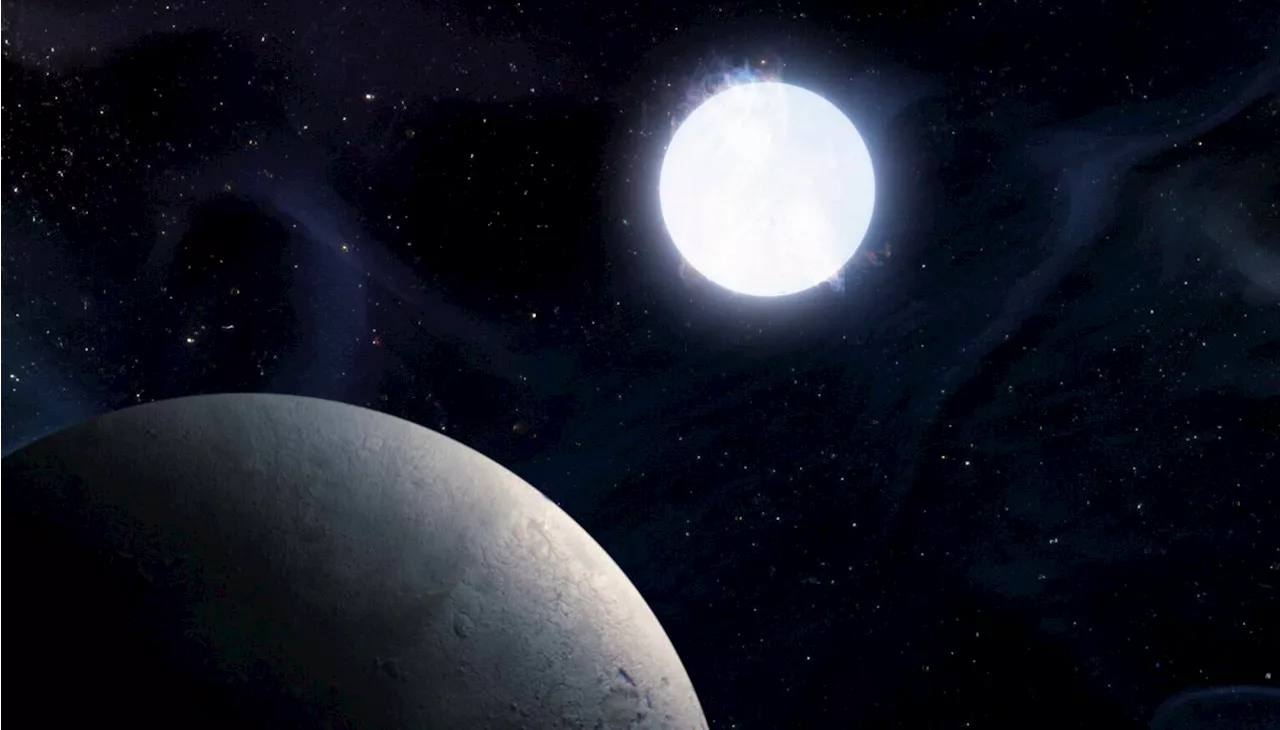A newly discovered exoplanet orbiting a white dwarf offers hope that Earth might survive the Sun's red giant phase in billions of years.
Astronomers have discovered a distant white dwarf with an Earth-like planet orbiting just beyond where Mars is in our solar system . This discovery offers some reassurance that Earth could survive the Sun's red giant phase on its way to becoming a white dwarf in about 8 billion years.\The exoplanet orbits its star, which is about half the mass of our Sun, at a distance roughly twice that of Earth today.
The system resembles what our solar system is expected to become once the Sun has exhausted its fuel and explodes as a supernova. This finding provides valuable insight into how planets fare as their stars reach the end of their life cycle.\The research team, led by former UC Berkeley doctoral student now at UC San Diego, includes colleagues from various institutions like UC Berkeley, Tsinghua University, Harvard & Smithsonian Center for Astrophysics, and NASA Goddard Space Flight Center. Their findings were published in the journal [Journal Name]
Exoplanet White Dwarf Red Giant Solar System Planet Survival
United States Latest News, United States Headlines
Similar News:You can also read news stories similar to this one that we have collected from other news sources.
 Snowball Earth: Researchers discover unique Scottish rocks record when Earth was first encased in iceMore than 700 million years ago, the Earth was plunged into a state that geologists call 'snowball Earth', when our planet was entirely encased in ice. This happened when the polar ice caps expanded so far that they joined up around the equator.
Snowball Earth: Researchers discover unique Scottish rocks record when Earth was first encased in iceMore than 700 million years ago, the Earth was plunged into a state that geologists call 'snowball Earth', when our planet was entirely encased in ice. This happened when the polar ice caps expanded so far that they joined up around the equator.
Read more »
 Mini moon spotted by astronomers will orbit Earth for nearly two monthsWASHINGTON (AP) — Earth’s moon will soon have some company — a “mini moon.”The mini moon is actually an asteroid about the size of a school bus at 33 feet (10 m
Mini moon spotted by astronomers will orbit Earth for nearly two monthsWASHINGTON (AP) — Earth’s moon will soon have some company — a “mini moon.”The mini moon is actually an asteroid about the size of a school bus at 33 feet (10 m
Read more »
 Astronomers Discover Supermassive Black Hole With Unprecedented Twin JetsA team of astronomers has made a remarkable discovery: a supermassive black hole with twin jets blasting out an incredible 23 million light years, the longest yet observed. This astonishing find sheds new light on the powerful forces at play in these enigmatic cosmic objects.
Astronomers Discover Supermassive Black Hole With Unprecedented Twin JetsA team of astronomers has made a remarkable discovery: a supermassive black hole with twin jets blasting out an incredible 23 million light years, the longest yet observed. This astonishing find sheds new light on the powerful forces at play in these enigmatic cosmic objects.
Read more »
 Astronomers discover a long-hidden small black hole in an unusually evolved binary systemChinese researchers have discovered a promising mass-gap black hole using radial velocity and astrometry methods. The study was published online in Nature Astronomy on Sept. 10, and was conducted by a team led by Dr. Wang Song, an associate researcher from the National Astronomical Observatories of the Chinese Academy of Sciences (NAOC).
Astronomers discover a long-hidden small black hole in an unusually evolved binary systemChinese researchers have discovered a promising mass-gap black hole using radial velocity and astrometry methods. The study was published online in Nature Astronomy on Sept. 10, and was conducted by a team led by Dr. Wang Song, an associate researcher from the National Astronomical Observatories of the Chinese Academy of Sciences (NAOC).
Read more »
 Astronomers discover new planet in Great Bear constellationAstronomers from the Nicolaus Copernicus University in Torun have discovered a new planet in the constellation of the Great Bear. It has a mass as much as 11 times that of Jupiter, orbits its star in 14 years and has a temperature of no more than minus 100 degrees Celsius.
Astronomers discover new planet in Great Bear constellationAstronomers from the Nicolaus Copernicus University in Torun have discovered a new planet in the constellation of the Great Bear. It has a mass as much as 11 times that of Jupiter, orbits its star in 14 years and has a temperature of no more than minus 100 degrees Celsius.
Read more »
 Astronomers discover new feature in exoplanet distribution that's between the Neptunian Desert and SavannaAstronomers have uncovered the 'Neptunian Ridge,' a newly identified feature in the distribution of exoplanets.
Astronomers discover new feature in exoplanet distribution that's between the Neptunian Desert and SavannaAstronomers have uncovered the 'Neptunian Ridge,' a newly identified feature in the distribution of exoplanets.
Read more »
